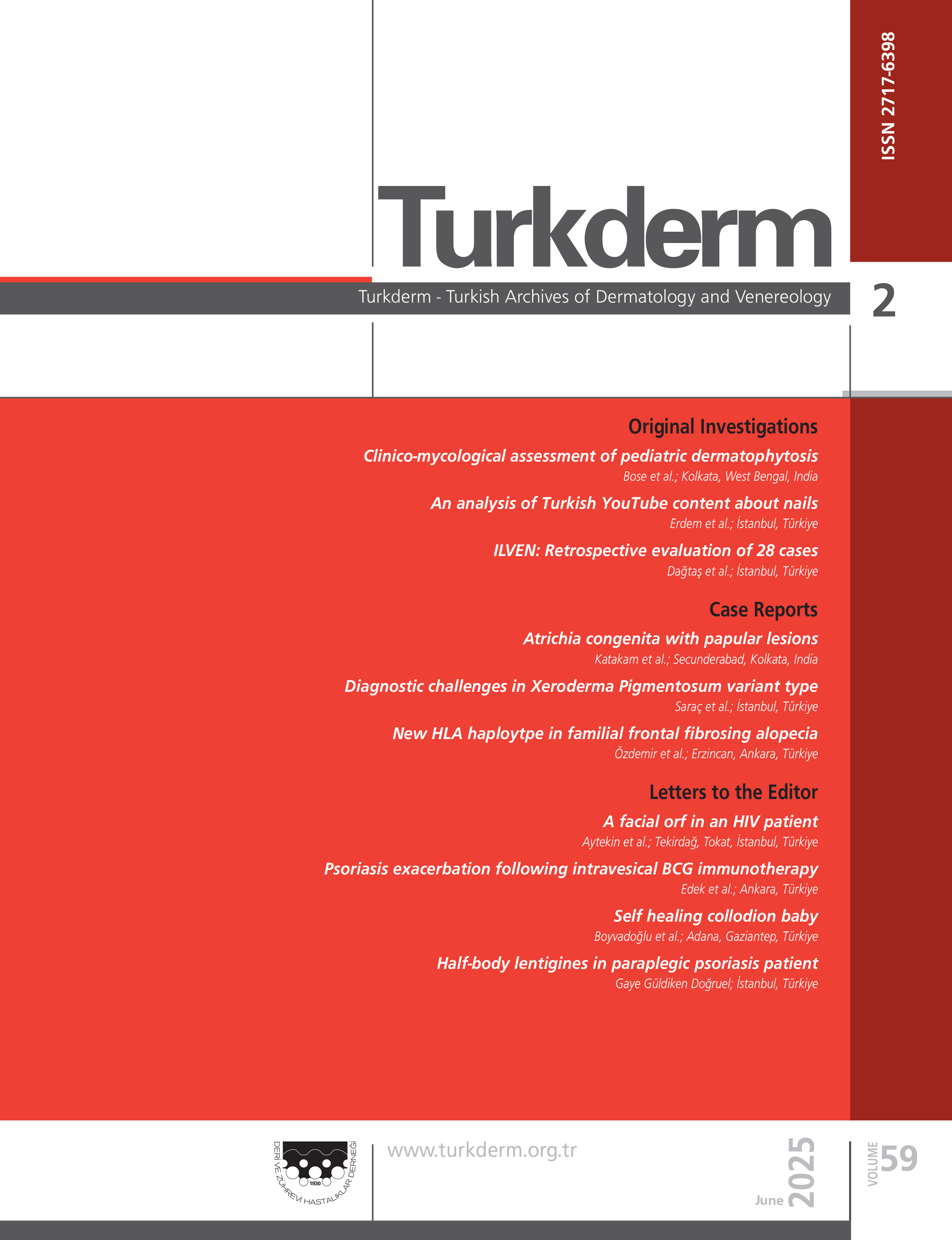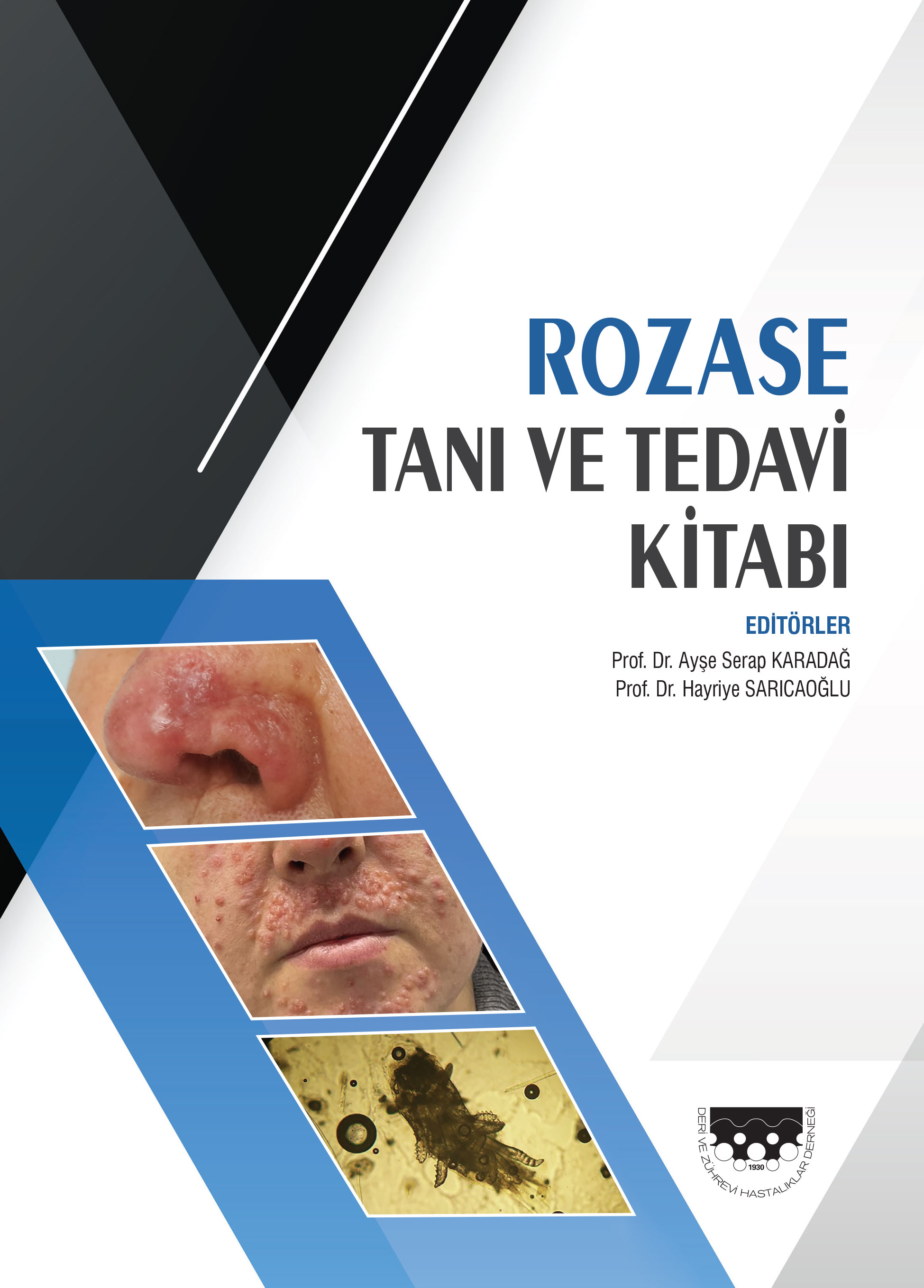Volume: 46 Issue: 1 - 2012
| EDITORIAL | |
| 1. | New Beauties of Our Expression Language Ali Tahsin Güneş Pages 1 - 2 Abstract | |
| REVIEW ARTICLE | |
| 2. | Psoriasis and Obesity Mehmet Ali Gürer, Hilal Gökalp doi: 10.4274/turkderm.98215 Pages 3 - 6 In recent years, it has been thought that a strong association exists between metabolic syndrome, specifically obesity, and psoriasis. Obesity is a multifactorial disease affected by both genetic and environmental factors. Adipokines (e.g. leptin) secreted by the adipose tissue are believed to play a role in the pathogenesis of psoriasis. The main role of leptin is to adjust metabolism by controlling appetite. Serum leptin levels in patients with severe and moderate psoriasis were found to be higher than in normal control groups. In many similar studies, leptin secretion has been found to stimulate keratinocyte proliferation, which is one of the characteristics of psoriasis. Although many studies showed increased prevalence of obesity in psoriasis patients, few others reported development of obesity in psoriasis patients. Additionally, obesity was found to affect treatment responses not only in classical systemic/topical treatment approaches in psoriasis, but also in newer biological treatments. Overall, increasing epidemiological evidence suggests strong association between obesity and psoriasis, increase in serum leptin levels is thought to have a major role, and weight loss may have significant impact on response to treatment. |
| ORIGINAL INVESTIGATION | |
| 3. | Serum Neopterin and TNF-α Levels in Psoriasis and Their Correlation with Disease Severity Ali Murat Ceyhan, Mehmet Yıldırım, Betül Mermi Ceyhan, Recep Sütçü doi: 10.4274/turkderm.60243 Pages 7 - 10 Background and Design: Psoriasis is a T cell-mediated autoimmune skin disease characterized by hyperproliferation of keratinocytes and accumulation of activated T cells responding to a hitherto unidentified antigenic stimulus. Tumor necrosis factor-α (TNF-α) plays an essential role in the induction and maintenance of psoriatic lesion. Neopterin is a non-specific immunological marker of cellular immune activation, which is produced by human monocytes/macrophages as a result of interferon-gamma secretion by activated T lymphocytes. The aim of the presented study was to determine the levels of serum neopterin and TNF-α in psoriatic patients and to evaluate whether Psoriasis Area correlated with Severity Index (PASI) and serum levels of neopterin and TNF-α. Materials and Methods: Forty patients with psoriasis and thirty-seven healthy controls were included in this study. Serum neopterin and TNF-α levels in all subjects were measured by the Enzyme Immunoassay (ELISA) method. The disease severity index was assessed in psoriatic patients by means of PASI and correlation of PASI scores with serum levels of neopterin and, TNF-α was investigated.. Results: The mean values of serum neopterin levels were significantly higher in patient group compared to healthy controls (11.04±5.42 nmol/L and 5.44±2.40 nmol/L, respectively, p<0.001). The mean of serum TNF-α concentrations were also found to be significantly elevated in patients with psoriasis (8.51±2.34 pg/ml) than in controls (7.09±1.77 pg/ml, p=0.013). However, PASI scores did not significantly correlated with serum levels of neopterin and TNF-α (p>0.05, r=-0.096, r=0.089, respectively). No statistically significant correlation was found between serum neopterin levels and serum TNF-α levels (p>0.05, r=0.214). Conclusion: These results indicate that serum neopterin and TNF-α levels may not be used as a reliable immunological marker for monitoring the severity of psoriasis. |
| 4. | Comparison of Efficiency and Adverse Effects of Etanercept, Infliximab and Adalimumab in Patients with Psoriasis Vulgaris Ayşe Pekdemir Şen, Nahide Onsun, Özlem Su Küçük, Ayşe Cinkaya doi: 10.4274/turkderm.34976 Pages 11 - 14 Background and Design: Our aim was to evaluate and compare the effects, side effects, and onset and duration of action of etanercept, infliximab and adalimumab on patients followed in our psoriasis outpatient clinic. Material and Method: Data was collected retrospectively from patient medical records. The study group was divided into three groups as follows: group 1 (n: 48) - patients on etanercept treatment, group 2 (n: 49) - on infliximab treatment and group 3 (n: 18) - on adalimumab treatment. Age, gender, duration of disease, PASI values at 0 (baseline), 6, 12, 24, 36, and 52 weeks and side effects were evaluated. Results: 55.7% (n=64) of patients were male, 44.3% (n=51) were female. The median age of study group was 44.53±12.91 (13-79) years, the median duration of the disease was 17.02±10.24 (1-60) years, and the median initial PASI value was 15.31±8.45. The treatment was discontinued because of side effects: One of four patients had elevated liver enzymes, 1 - herpes zoster besides increased liver enzymes, 1 - congestive heart failure, and 1 patient had pneumonia, in group 1, two of three patients developed severe infusion reaction, 1 had severe nausea and fatigue, in group 2. Isoniazid intolerance was established in 1 patient in group 1, group 2 and group 3. PASI 75 values at 6th week in groups 1, 2 and 3 were 27.27%,49.99%,46.66%; at 12th week 75.75%, 85.28%, 66.66%; at 24th week 93.54%, 86.66%, 83.33%; and at 52nd week 92.3%, 84%, 81.81%, respectively. Conclusion: Our data showed that all three biologic agents were effective in the treatment of moderate to severe psoriasis patients. Although not statistically significant, infliximab and adalimumab were more successful in terms of rapid control, whereas etanercept was more promising for continuous and high efficiency in chronic plaque psoriasis. |
| 5. | Assesment of Hearing Loss in Patients with Psoriasis Serdar Cenk Güvenç, Hakan Turan, Süleyman Yılmaz, Mehmet Emin Yanık, Abdullah Berada, Cihangir Aliağaoğlu doi: 10.4274/turkderm.15986 Pages 15 - 19 Background and Design: Psoriasis is an autoimmune chronic inflammatory skin disease characterized by T-cell mediated hyperproliferation of keratinocytes. Sensorineural hearing loss accompanied by autoimmune diseases was first described by McCabe in 1979. Cases of hearing loss associated with various autoimmune diseases have been reported. However, the number of studies evaluating the hearing loss in patients with psoriasis is insufficient. In this study, we aimed to assess hearing loss in psoriasis patients. Material and Methods: Fifty-one psoriasis patients, who were admitted to our outpatient clinic in 2010, and 51 healthy volunteers were included in the study. All participants underwent a complete ear, nose and throat examination before audiological assessment followed by, pure-tone audiometry in a sound-isolated audiology laboratory. Statistical analysis was performed using PASW Statistics version 18.0.0. A p-value less than 0.05 was considered statistically significant. Results: The mean bone and hearing thresholds were higher for all frequencies in patients than in controls. The values reached statistical significance at all frequencies except for right ear air conduction at 1000 Hz, bone conduction at 500 and 1000 Hz, left ear air conduction at 500 Hz, and bone conduction at 500 Hz (p<0.05). We compared the Psoriasis Area and Severity Index (PASI) scores adjusted for age and disease duration and thresholds matched with frequencies and found a significant correlation between PASI score and hearing loss at medium and high frequencies. Conclusion: In psoriasis, chronic inflammation is thought to be the main pathological process destroying structure and functions of skin, nails and joints. We think that the same process may affect the cochlea in a similar way. The correlation between high PASI scores and hearing loss at medium and high frequencies may be an unexpected result of increased inflammatory mediators responsible from the disease in exacerbation periods. |
| 6. | Knowledge, Behavior and Attitudes of University Students toward Sexually Transmitted Infections Kurtuluş Didem Yazganoğlu, Güzin Özarmağan, Ayşegül Tozeren, Nuray Özgülnar doi: 10.4274/turkderm.31957 Pages 20 - 25 Background and Design: This study evaluates the knowledge, behavior and attitudes about sexually transmitted infections (STIs) among university students attending faculties other than medicine. Materials and Methods: A cross-sectional and descriptive study was designed. A self-administered questionnaire comprising 37 questions was administered to students of Turkish nationality in a six-week period who attended to medico. Three hundred and eighty eight students completed the questionnaire. Results: Among students, 56.9% were female and 43.1% were male. Mean age was 21.18±2.46. Of the students, 76.9% claimed that they knew about STIs. Internet (63.9%) was the most common source of information, followed-by friends (48%). HIV was the most common known disease as a STI (96.8%), followed-by gonorrhea, syphilis, hepatitis-B, genital herpes, genital warts, hepatitis-C. Of the respondents, 93.7% knew that STIs could be transmitted by vaginal sex, while 69% knew about transmission by blood, 48.9% by anal sex and 32% by oral sex. The rate of students who did not know any of the symptoms of STIs was 32.9%. Of the females 13.3% and of the males 51.6% stated to have sexual experience with statistically significant difference among sexes (c2=62.722, p=0.001). Females reported first sexual intercourse at an older age than males (t=3.970, p=0.001). Approximately half of the males (55.8%) and nearly all of the females (95.8%) who reported to have sexual activity had 2 or less sexual partners (c2=9.564, p=0.008). Both sexes showed risky sexual behavior about condom use (c2=3.210, p=0.523). Conclusion: It seems that most of the Turkish university students are not aware of STIs other than HIV. They especially lack knowledge about symptoms, complications and transmission routes of STIs. The low rate of condom use shows their risky behavior to get STI. Lack of knowledge about STIs, condom use and risky sexual behaviors among university students deserve attention to the lack of education on this matter in our country. |
| 7. | Clinical Features of Herpes Zoster Infections in Childhood Emine Çölgeçen, Öznur Küçük, Mehmet Balcı doi: 10.4274/turkderm.94899 Pages 26 - 28 Background and Design: Herpes zoster (HZ) is a rare disease in childhood and encountered especially in immunosuppressed patients. The aim of this study was to determine the clinical features of HZ in children. Materials and methods: Records of 24 children, who had a diagnosis of HZ and were referred to the dermatology and pediatric outpatient clinic during February 2009-February 2011, were evaluated retrospectively. Results: Twenty-four patients, - 14 female (58.3%, 10 male (41.7%) -, aged between 4 and 16 years were assessed. The mean age of the patients was 10.6±3.7 years. The most frequent complaint was pruritus (54.2%). Sixteen patients had thoracic involvement, whilst the rest had lumbar (n: 4), trigeminal (n: 3) and sacral (n: 1) involvements, respectively. Eleven children were distressed and 2 children had physical trauma. Ten patients were treated with acyclovir orally, 3 were given valacyclovir orally and the rest had only local treatment. No complications were reported. Conclusion: HZ may be seen in healthy children with no immunosuppresion and the infection in these patients has a favorable course. |
| 8. | The Effect of Isotretinoin Administration on Anxiety and Depression Scores in Patients with Acne Vulgaris Hatice Nur Azaklı, Emine Derviş, İlknur Altunay, Sinem Gönenli doi: 10.4274/turkderm.01488 Pages 29 - 32 Background and Design: In this study, we aimed to determine whether isotretinoin, used in the treatment of acne vulgaris, causes depression and anxiety symptoms by evaluating its effect on depression and anxiety scale scores. Materials and Methods: Eighty-nine acne vulgaris patients (F/M: 60/29, age range: 16-36 years), who had attended the outpatient clinic of the Department of Dermatology at Haseki Education and Research Hospital between 2007 and 2009, were enrolled in the study. The clinical severity of acne vulgaris was between grade 4 and grade 8 according to Allen-Smith Scale. All patients were unresponsive to several previously applied topical acne preparations or systemic antibiotics treatments and had indication for isotretinoin use. The Hospital Anxiety and Depression Scale was administered to all patients twice; before and at the end of 16-week treatment. Results: There was no significant difference between pre- and post-treatment anxiety and depression frequency and scores in patients treated with isotretinoin (p>0.05). Conclusion: The findings of the present study do not support the presence of association between isotretinoin and depression. |
| 9. | Efficacy of Topical Sodium Sulfacetamide in the Treatment of Mild and Moderate Acne Vulgaris: A Randomized, Comparative Study Ayşegül Turan, Hayriye Sarıcaoğlu, Emel Bülbül Başkan, Hakan Turan, Kenan Aydoğan doi: 10.4274/turkderm.77698 Pages 33 - 38 Background and Design: Clindamycin and erythromycin are the most widely used topical antibiotics in the treatment of mild to moderate acne vulgaris. The combination of topical antibiotics with benzoyl peroxide increases the efficacy of the treatment and reduces antibiotic resistance of Propionibacterium acnes. Sodium sulfacetamide is a sulfonamide antibiotic. Although it has been known for many years, it is not widely used in acne treatment. However, it has recently acquired currency again. In this study, we aimed to assess the efficacy of sodium sulfacetamide in the treatment of mild to moderate acne vulgaris and to compare with the other widely used topical antibiotics. Material and Method: In our comparative study, 60 patients with acne vulgaris were randomly assigned into 3 groups, wherein the 1st, 2nd, and 3rd groups were applied sodium sulfacetamide 10% lotion, clindamycin 1% lotion, and erythromycin 2% gel, respectively, twice daily for 12 weeks. Each group consisted of 20 subjects. The treatment was combined with benzoyl peroxide in all groups. The patients were assessed for noninflammatory (open and closed comedones) and inflammatory (papules and pustules) lesion counts at 4, 8, and 12 weeks and, adverse events were recorded. Results: There was no significant difference between the groups for age, sex and acne duration (p>0.05). Statistically significant decrease was obtained with all 3 treatment regimens at the end of the study (p<0.05). No significant difference was detected between the 3 groups regarding noninflammatory and total lesion counts at 4, 8, and 12 weeks, however, clindamycin was superior to other treatments at the 8th week regarding inflammatory lesion counts (p<0.05). There was no statistically significant difference in adverse effect rates between the three groups (p>0.05). Conclusion: In this study, topical sodium sulfacetamide was found to be as effective and safe as erythromycin and clindamycin when combined with benzoyl peroxide in the treatment of mild to moderate acne vulgaris. These results should be supported by studies with larger cohorts. |
| 10. | Quality of Life, Anxiety and Depression Levels in Patients with Seborrheic Dermatitis Mustafa Aksoy, Evrim Özkorumak, Sevgi Bahadır, Savaş Yaylı, Deniz Aksu Arıca doi: 10.4274/turkderm.83792 Pages 39 - 43 Background and Design: Seborrheic dermatitis is a common disease characterized by the presence of erythematous plaques with oily-yellow desquamation. Due to its chronic course with remission and exacerbation periods, seborrheic dermatitis can give rise to impaired quality of life and increased levels of anxiety and depression. The purpose of this study was to evaluate the levels of anxiety and depression and quality of life in patients with seborrheic dermatitis. Material and Method: This study was conducted with 50 consecutive patients admitted to our clinic, who have been diagnosed with seborrheic dermatitis without any other systemic or psychiatric illnesses (patient group), and 50 healthy subjects with similar sociodemographic characteristics (control group). Dermatological Life Quality Index (DLQI) was administered to patient group; the Beck Depression Inventory (BDI) and the Beck Anxiety Inventory (BAI) were administered to both patient and the control groups. Results: In one half (%50) of the patients, quality of life was found to be slightly affected or not affected at all, in the other half (%50), the quality of life was affected reasonably or greatly. Anxiety and depression levels were higher in seborrheic dermatitis patients with distortion in quality of life. Also, there was a positive correlation between the levels of anxiety and depression. Conclusion: This study showed that the quality of life was affected by the seborrheic dermatitis negatively, and anxiety and depression levels were higher as much as the impairment of quality of life. According to these results, identifying the psychological symptoms of illness and dealing with these symptoms are important for both in increasing quality of life of patients and getting a well response to the treatment. |
| TURKDERM-9860 | |
| 11. | A Case of Cutaneous Leishmaniasis Mimicking Squamous Cell Carcinoma Ali Murat Ceyhan, Gonca Meriç, Giray Aynali doi: 10.4274/turkderm.93753 Pages 44 - 46 Cutaneous leishmaniasis (CL) is a parasitic disease caused by protozoan belongs to the Leishmania genus and is transmitted to human skin by the bite of infected sand flies. It is still considered an important health issue in many parts of the world including our country. CL is most commonly seen in childhood and the lesions more frequently occur on the exposed parts of the body such as the face, neck and the extremities. The diagnosis of CL is quite easy in typical cases found in the endemic areas. However, the clinical spectrum of CL can be very broad and it can mimic a number of common dermatoses. Depending on subspecies of the Leishmania, immune response of the host and age, it may represent quite different and atypical cutaneous manifestations which elude diagnosis in the first instance. The variety of cutaneous findings and unusual presentations can lead to diagnostic challenge especially for inexperienced physicians in non-endemic areas where the disease is less frequently seen. In this report, we describe a case of CL which clinically mimicked squamous cell carcinoma in a 76-yearold female farmer living in a non-endemic area. |
| 12. | Three Familial Cases with Ectrodactyly Ectodermal Displazia-Clefting Syndrome Selma Bakar Dertlioğlu, Demet Çiçek, İlyas Özardalı doi: 10.4274/turkderm.65707 Pages 47 - 49 A family of four children where mother and father had history of consanguineous marriage presented at our clinic due to lack of hair growth, thinning of all body hair and finger deformities in their three daughters aged 10 years, six years and three months. Dermatological examination of the cases showed thinning of the hair on the scalp, eyebrows, and extremities, subungual hyperkeratosis in nails, palmoplantar hyperkeratosis, cutaneous xerosis and loss of sweating, conical appearance and hypodontia in the teeth. All three siblings were seen to have the 3rd and 4th digits on the hand and the 2nd, 3rd and 4th digits on the feet to be proximally conjoined. Histopathologic examination of the cutaneous biopsy materials taken from the patients revealed a decrease in the number and size of hair follicles and sebaceous glands. We present these familial cases who were diagnosed with Ectrodactyly-ectodermal dysplasia-clefting syndrome as a result of clinical and histopathologic evaluation due to their rarity. |
| 13. | Harlequin Syndrome With Hemifacial Atrophy: A Case Study Mualla Polat, Esra Tuğ, Halil İbrahim Atasoy, Ali Haydar Parlak doi: 10.4274/turkderm.59455 Pages 50 - 52 Harlequin syndrome is an autonomic syndrome of heat, emotion and exercise induced flushing and sweating limited to one side of the face in combination with impairment of sweating and flushing on the contralateral side. Facial flushing and sweating has been named the "Harlequin Sign". This rare feature, "Harlequin Sign", represents a local autonomic dysfunction due to a cervical sympathetic deficit located at the pre or postganglionic level on the non-flushing side. Harlequin syndrome overlaps with several other syndromes. Parry-Romberg syndrome is a rare clinical entity of an unknown etiology. It is also described as progressive hemifacial atrophy. We report a nine-years old Turkish boy with asymmetrical facial sweating, flushing and hemifacial atrophy on the right side of his face. Facial flushing and sweating are induced by exercise, thermal, and emotional stimuli. |
| 14. | Topical Dimethylsulfoxide: Successful Treatment of a Case of Localized Cutaneous Mucinosis Bengü Gerçeker Türk, Meltem Türkmen, İlgen Ertam, Sinem Yaprak Karavana, Tuğrul Dereli doi: 10.4274/turkderm.86658 Pages 53 - 54 Cutaneous mucinoses is a connective tissue disorder characterized by the abnormal deposition of mucin in the dermis. Treatment of the disorder is limited only to case reports because of the rarity of the disease. The literature about the usage of dimethyl sulfoxide in cutaneous mucinosis is limited only to a case report of scleromxyedema treated by oral administration of the chemical. Herein, we report a case of localized cutaneous mucinosis who have been treated successfully with topical 50% dimethyl sulfoxide bioadehesive gel. |
| WHAT IS YOUR DIAGNOSIS? | |
| 15. | What is Your Diagnosis? Şirin Yaşar, Pembegül Güneş, Zehra Aşiran Serdar Pages 55 - 56 Abstract | |
| FROM THE DEPTHS OF DERMATOLOGY | |
| 16. | From the Depths of Dermatology Ekin Şavk Page 57 Abstract | |
| NEW PUBLICATIONS | |
| 17. | New Publications: Treatment of Metastatic Melanoma Page 58 Abstract | |























